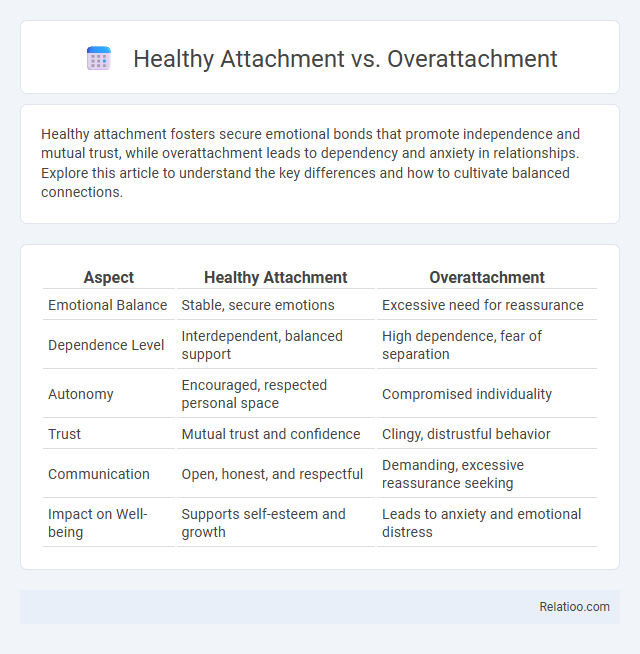Healthy attachment fosters secure emotional bonds that promote independence and mutual trust, while overattachment leads to dependency and anxiety in relationships. Explore this article to understand the key differences and how to cultivate balanced connections.
Table of Comparison
| Aspect | Healthy Attachment | Overattachment |
|---|---|---|
| Emotional Balance | Stable, secure emotions | Excessive need for reassurance |
| Dependence Level | Interdependent, balanced support | High dependence, fear of separation |
| Autonomy | Encouraged, respected personal space | Compromised individuality |
| Trust | Mutual trust and confidence | Clingy, distrustful behavior |
| Communication | Open, honest, and respectful | Demanding, excessive reassurance seeking |
| Impact on Well-being | Supports self-esteem and growth | Leads to anxiety and emotional distress |
Understanding Attachment: An Overview
Healthy attachment promotes secure emotional bonds characterized by trust, autonomy, and mutual respect, supporting psychological well-being and resilience. Overattachment involves excessive dependence on relationships, often leading to anxiety, fear of abandonment, and impaired emotional regulation. Understanding these attachment patterns is crucial for identifying maladaptive behaviors and fostering healthier interpersonal connections.
Defining Healthy Attachment
Healthy attachment is characterized by a secure emotional bond where you feel safe, understood, and supported, promoting trust and independence. Overattachment involves excessive dependence on others, leading to anxiety and difficulty in setting boundaries. Unlike healthy attachment, overdependence can hinder personal growth and emotional resilience.
Signs of Healthy Attachment in Relationships
Signs of healthy attachment in relationships include mutual trust, emotional availability, and consistent communication, fostering security and intimacy between partners. Individuals with secure attachment comfortably express needs and support each other's growth without clinginess or dependence. Unlike overattachment, healthy bonds balance closeness with personal boundaries, promoting independence alongside connection.
What is Overattachment?
Overattachment occurs when an individual develops an excessive emotional dependence on another person, often leading to clinginess and anxiety. This differs from healthy attachment, which fosters security and trust, and from overattachment, which involves an imbalanced need for closeness that can hinder personal growth and autonomy. Recognizing overattachment is crucial for establishing boundaries and maintaining emotional well-being in relationships.
Common Causes of Overattachment
Overattachment often stems from inconsistent caregiving, childhood trauma, or unmet emotional needs, leading to excessive dependence on relationships for validation and security. Unlike healthy attachment, which fosters trust and emotional balance, overattachment triggers anxiety and fear of abandonment, negatively impacting Your interpersonal dynamics. Recognizing these common causes helps identify patterns and promotes healthier emotional connections.
Emotional Impact of Overattachment
Overattachment often leads to heightened anxiety, emotional dependency, and difficulty in setting healthy boundaries, negatively impacting mental well-being. In contrast, healthy attachment fosters secure emotional connections, promoting resilience and balanced relationships. Overattachment can cause chronic stress and fear of abandonment, resulting in emotional instability and impaired social functioning.
Key Differences Between Healthy Attachment and Overattachment
Healthy attachment fosters secure emotional bonds characterized by trust, empathy, and balanced dependence, promoting psychological resilience and interpersonal growth. Overattachment manifests as excessive reliance on a person or object, leading to anxiety, clinginess, and impaired autonomy. Key differences include the presence of mutual respect in healthy attachment versus dependency-driven control seen in overattachment, as well as the ability to function independently without distress in healthy attachment, contrasting the fear of abandonment typical in overattachment.
How Overattachment Affects Personal Growth
Overattachment limits your ability to develop independence and emotional resilience, as it creates reliance on others for validation and security. This dependency hampers personal growth by fostering fear of separation and resistance to change. Healthy attachment, in contrast, supports balanced relationships that promote self-confidence and autonomy.
Strategies to Foster Healthy Attachment
Strategies to foster healthy attachment include consistent, responsive caregiving that meets a child's emotional and physical needs, promoting secure emotional bonds and trust. Encouraging open communication and providing a supportive, predictable environment helps children develop independence without fear of abandonment. Balancing closeness with appropriate boundaries prevents overattachment, ensuring relationships remain healthy and promote emotional resilience.
Seeking Support: When to Get Help for Attachment Issues
Recognizing when to seek support for attachment issues is crucial for your emotional well-being. Healthy attachment allows you to form secure, trusting relationships, whereas overattachment can lead to dependency and anxiety, impacting mental health negatively. If feelings of insecurity or clinginess interfere with daily life or relationships, consulting a therapist or counselor specializing in attachment can provide effective strategies for healing and growth.

Infographic: Healthy attachment vs Overattachment
 relatioo.com
relatioo.com